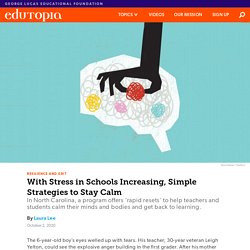

Microsoft EducationReimagined Paper. Hablemos de política educativa en América Latina y el Caribe #2: De la educación a distancia a la híbrida: 4 elementos clave para hacerla realidad. With Stress in Schools Increasing, Simple Strategies to Stay Calm. The 6-year-old boy’s eyes welled up with tears.

His teacher, 30-year veteran Leigh Yelton, could see the explosive anger building in the first grader. After his mother died unexpectedly in his kindergarten year, he struggled with what his grandmother called “mommy days,” or periods during which he would often cry uncontrollably. Instead of asking him what was wrong or trying to distract him, Yelton asked him to do something simple and unexpected: go to a private part of the room and push against a wall. It worked. Yelton learned the technique from a resilience training program that shows teachers how to help themselves—and their students—calm the central nervous system. Video “Our thinking brain is where we process language, so if I have flipped my lid, and you talk to me, you sound like the Charlie Brown teacher,” says Ann DuPre Rogers, executive director of Resources for Resilience, the nonprofit organization that conducts the training.
Understanding Triggers Put On Your Mask First.
Ciudades Visibles – Proyecto transmedia en educación. Revista COLEGIO edicion 91. The Science of Keeping Kids Engaged—Even From Home. The sudden, unplanned move to distance learning during spring 2020 drove a wedge into the middle of the school year—disrupting academic schedules, putting an end to extracurriculars, and undercutting the assessment and academic feedback cycles in most schools.

Student motivation, predictably, foundered. As one of our students put it, online school “is just like in-person school but with all the fun bits removed.” Without the ambient social interactions that are such a rich part of a regular day at school, and without in-person guidance from teachers, coaches, and counselors, many of the key motivational drivers were suddenly gone.
In most K–12 schools, there were no fully formed distance-learning alternatives waiting in the wings. In short order, the move to online learning also laid bare some of the instructional flaws in our traditional structures of accountability, evaluation, and standardized testing. A Two-Stage Approach to Motivation Creating a Sense of Belonging. The Science of Keeping Kids Engaged—Even From Home. How to Help Elementary Students Get Used to Masks. Our brains do not like surprises—they love to make predictions by finding patterns that are familiar, and they learn from associations, connections, and patterned experiences.

But as schools begin to resume in late summer, there will be many unfamiliar experiences: new routines, schedules, and guidelines. Especially for young students, it’s going to be challenging at best to adjust to wearing masks for extended periods. States, districts, and schools that are returning to in-class teaching will have a variety of regulations and protocols, and we need to think collectively about how we can help young students follow those protocols. Parents can help by getting their kids used to wearing masks for increasing intervals even before school begins, and I have some suggestions for how we might introduce masks to students while creating safe and predictable environments to allay the expected fear and anxiety these changes could create. Strategies for Starting the Year in Masks 1. 2. 3. 4. 5. 6.
Growth Mindset Blog – Big Life Journal. EV - Aprendizaje basado en proyectos. Edutopia guia diez consejos para evaluar PBL espanol. Las preguntas educativas – ¿Qué sabemos de educación? Guía para padres: cómo ayudar a los hijos en la continuidad pedagógica en cuarentena sin morir en el intento. El viernes 13 de marzo fue el último día que las niñas y niños de la Argentina concurrieron a clases.

Habían transcurrido sólo dos semanas de un ciclo lectivo que se vio interrumpido tras decretarse la emergencia sanitaria en el país por un nuevo virus que tenía al mundo en vilo. También dejaron de ir a los establecimientos educativos los adolescentes del nivel secundario y los estudiantes universitarios. Los pequeños de jardín de infantes no habían llegado a completar la famosa -y tediosa para más de un padre- adaptación.
Así, mientras los uniformes todavía tenían olor a nuevo y muchos libros no habían sido estrenados, todos los actores de esta película -entidades, padres, docentes y niños- comenzaron a hacerse a la idea de que la realidad había cambiado. Para empezar, hay que tener en claro que este es un momento especial, son tiempos de pandemia, y tal como la salud está en emergencia, la interrupción de las clases representa una “urgencia educativa”. ¿Por dónde comenzar? El aire libre como aliado para una vuelta a las aulas diferente.